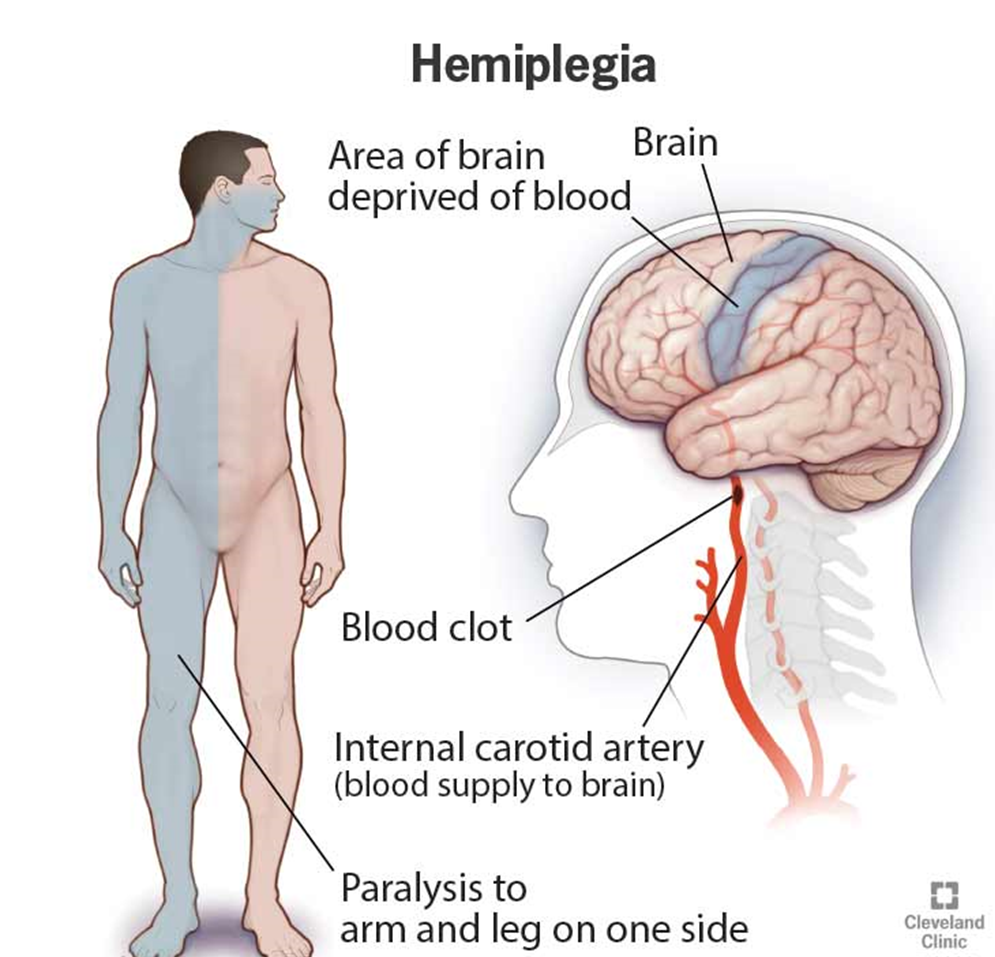A nurse is caring for clients on the med-surg unit. Which client may have an increased risk for body-image disturbance?
A client who had a cardiac catheterization.
A client who had an appendectomy.
A client who had a stroke with left-sided hemiplegia.
A client who had shoulder surgery.
The Correct Answer is C
Choice A reason: This is not the client who has an increased risk for body-image disturbance. A cardiac catheterization is a procedure that involves inserting a thin tube into a blood vessel and guiding it to the heart. It is used to diagnose or treat heart problems. It does not cause any visible changes to the body or affect the client's appearance or function.
Choice B reason: This is not the client who has an increased risk for body-image disturbance. An appendectomy is a surgery that involves removing the appendix, which is a small pouch attached to the large intestine. It is used to treat appendicitis, which is an inflammation of the appendix. It does not cause any significant changes to the body or affect the client's appearance or function.
Choice C reason: This is the client who has an increased risk for body-image disturbance. A stroke is a condition that occurs when the blood supply to a part of the brain is interrupted, causing brain cells to die. It can cause various neurological impairments, depending on the location and severity of the damage. Left-sided hemiplegia is a paralysis of the left side of the body, which can affect the client's movement, sensation, speech, and facial expression. It can cause a noticeable change to the body and affect the client's appearance and function.
Choice D reason: This is not the client who has an increased risk for body-image disturbance. Shoulder surgery is a surgery that involves repairing or replacing the structures of the shoulder joint, such as the bones, muscles, tendons, or ligaments. It is used to treat shoulder injuries or disorders, such as fractures, dislocations, arthritis, or rotator cuff tears. It does not cause any major changes to the body or affect the client's appearance or function.

Nursing Test Bank
Naxlex Comprehensive Predictor Exams
Related Questions
Correct Answer is C
Explanation
Choice A reason: This is not the client who has an increased risk for body-image disturbance. A cardiac catheterization is a procedure that involves inserting a thin tube into a blood vessel and guiding it to the heart. It is used to diagnose or treat heart problems. It does not cause any visible changes to the body or affect the client's appearance or function.
Choice B reason: This is not the client who has an increased risk for body-image disturbance. An appendectomy is a surgery that involves removing the appendix, which is a small pouch attached to the large intestine. It is used to treat appendicitis, which is an inflammation of the appendix. It does not cause any significant changes to the body or affect the client's appearance or function.
Choice C reason: This is the client who has an increased risk for body-image disturbance. A stroke is a condition that occurs when the blood supply to a part of the brain is interrupted, causing brain cells to die. It can cause various neurological impairments, depending on the location and severity of the damage. Left-sided hemiplegia is a paralysis of the left side of the body, which can affect the client's movement, sensation, speech, and facial expression. It can cause a noticeable change to the body and affect the client's appearance and function.
Choice D reason: This is not the client who has an increased risk for body-image disturbance. Shoulder surgery is a surgery that involves repairing or replacing the structures of the shoulder joint, such as the bones, muscles, tendons, or ligaments. It is used to treat shoulder injuries or disorders, such as fractures, dislocations, arthritis, or rotator cuff tears. It does not cause any major changes to the body or affect the client's appearance or function.

Correct Answer is D
Explanation
Choice A reason: This is not a statement that indicates an issue with self-concept. The client acknowledges their difficulty with the colostomy appliance, but also shows that they have family support and assistance. This suggests that the client has a positive self-concept and coping skills.
Choice B reason: This is not a statement that indicates an issue with self-concept. The client expresses their willingness to communicate with their relative who has a colostomy. This indicates that the client has a positive self-concept and social support.
Choice C reason: This is not a statement that indicates an issue with self-concept. The client recognizes that learning to manage the colostomy may take some time and practice. This implies that the client has a positive self-concept and realistic expectations.
Choice D reason: This is the statement that indicates an issue with self-concept. The client expresses a negative and hopeless attitude towards the colostomy. This suggests that the client has a poor self-concept and low self-efficacy.
Whether you are a student looking to ace your exams or a practicing nurse seeking to enhance your expertise , our nursing education contents will empower you with the confidence and competence to make a difference in the lives of patients and become a respected leader in the healthcare field.
Visit Naxlex, invest in your future and unlock endless possibilities with our unparalleled nursing education contents today
Report Wrong Answer on the Current Question
Do you disagree with the answer? If yes, what is your expected answer? Explain.
Kindly be descriptive with the issue you are facing.
